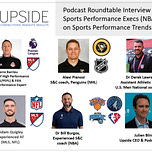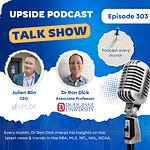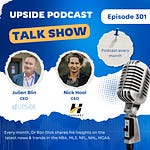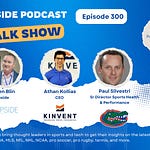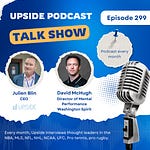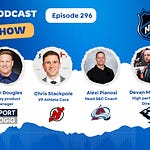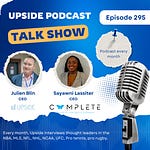This week we had the honor to interview again a group of sports performance experts.
Alexi Pianosi, S&C coach for the Pittsburgh Penguins, a top NHL team.
Pierre Barrieu, an experienced high performance director in the MLS (LA Galaxy, LAFC, Toronto FC, NY Red Bulls, etc.), Premier League (Leeds United FC) and FIFA expert.
Dr Derek Lawrance, Assistant Athletic Trainer, U.S. Men’s Soccer National Team.
Dr Bill Burgos, an experienced NBA Strenght &Conditioning coach. He has worked for many NBA teams (Orlando Magic, NY Knicks, Timberloves..). He is also an adjunct professor at Mississippi state and Austin Peay State university.
Adam Quigley, an experienced athletic trainer in the MLS (LA Galaxy), NFL (Saints) & US Soccer national teams.
📝Show Notes: Through this interview, we touched on the best practices and tools that you have come across regarding Biomechanics and Control of Human Movement. We also discussed the best way to learn from other performance staff members about their roles. We also touched on the biggest mistakes made by sports performance startups that they have come across as well as the best approaches used by sports performance startups that they have come across. Lastly we talked about Messi’s debut in the MLS and Novak Djokovic’s quest to win his 24th grand slam.
🚀Best Quotes: Here are some of the key discussion points and best quotes from our conversation with Adam, Pierre, Alexi, Bill, and Derek:
On the best practices and tools that they have come across regarding Biomechanics and Control of Human Movement:
Alexi Pianosi:
“I think, coming from the world of hockey, the study of biomechanics, in the sport or in the sporting motions, is a little bit more difficult because you're on the ice. You have substantially more equipment than most sports”.
“So if you want to wear markers or tags or anything like that, it's a little bit more complicated. I know there are several companies that are trying to bridge what they've done in MLB or football, things like that, track and field into hockey, but it's a little difficult to this point. So I think we're still in the infancy of making some of those technologies work, at least from a hockey perspective”.
Pierre Barrieu:
“Biomechanics is best suited for some sports that are very technical. So sports like baseball come to mind, for example. The way I've used them and the way I would probably use them more in the future, would be as a screening tool to start with, for all the guys and then as a reference point in the RTP process, in case of later an injury”.
“When you look at thinks like: how's this injury? Has this affected his gait, his movement pattern? Where was he at before? Does he compensate more than in terms of performance? Rather than “let's have him move better” because I think we have some other issues we need to tackle first over a season. I have done this in MLS where we have an 11 months season. So I think in other sports, when you have a long off season, this is where and when the biomechanics can make a huge difference”.
Adam Quigley:
“I've seen a pretty wide range of implementations of biomechanical testing and baseline and usage for just monitoring. What I found to be really helpful is doing any types of movement screens that we're doing individually or anyways and maybe preseason utilizing some type of cameras, even if it's just a phone, you're sitting here videoing everyone”.
“Or if you have multi-directional cameras or multi-angle cameras and looking at their different movements and then maybe putting in force plates or combining a few different technologies to use for weight distribution and force output, and seeing how that can be used from a baseline to post-injury to return to play integration. It is applicable for basketball, football, hockey, whatever it is, on fields they are so dynamically complex. It's not just single plane movements”.
“This is definitely one of those collaborative efforts of, how do you get a athletic therapist or sports therapist, to figure out how to use biomechanics in their therapy or rehab, or you have biomechanical analysis be a part of a performance coach’s movement analysis per, without it taking over the entire perspective of like, this is right, this is wrong. It, it can simply be neutral, like this is just what is. And we can use that as information”.
Dr Derek Lawrance:
“The best tool and the common theme here is just a video camera. Hands down, that's going to be your main tool for any kind of biomechanical work here. And so if someone has a lower budget, even at a high school level here in America, you could do some biomechanical stuff by just simply using your phone, as Adam had mentioned”.
And then you can build off of that. This is something that we did at the club (SJ Earthquakes/MLS) I was at previously, where we didn't have a big budget, but we used a camera, and we were able to set up some iPads, the multi-angle stuff like Adam mentioned”.
“And we referred it to a physical therapist who was an expert in biomechanics because we consulted with him of what are the best tools that were best tests that we could do. If we found some red flags on some of the tests that we did in-house, we would send them to him and he would implement a video camera motion capture and force plate in a movement screen”.
Dr Bill Burgos:
“Regardless of the sport, we've always used a camera, whether I was at Velocity Sports Performance, we used Dart Fish when it first came out. And then I just used my phone. And Derek is right, the video camera is one of the most inexpensive tools that you could use to do biomechanical screenings”.
“But the thing is..you have to understand what you're looking for. We could do as many videos as we want, but we have to understand what we're looking for in order to make sense, even if you get the best tool out there, whether it's Dari or anything like that, if you don't understand it, and then how can it affect programming? That’s critical”.
On the best ways to learn the roles of others:
Pierre Barrieu:
“I think the best thing that has ever worked for me in terms of our organization and the teams I've been on, is that we got to know each other very well beyond the work environment. We had team outings, we got to learn from each other. And I think when we get to learn from each other in an environment where it's not the work setting, we get to understand who we are and why”.
“And then they get to understand your role as well. I think these are the best things that help put together a successful team in terms of the high performance staff. But the other thing I did early on in my career, I took the initiative as well as some other ones, to learn more about each profession”.
“I've done observation hours in the physical therapy. I was a student athletic trainer. So I did those things. I understand sports science, I do a lot of that. I understand being a biomechanist, things of that nature. But it takes the person itself who has to take the initiative to understand that role, to understand where, what that person's thinking on top of understanding who that person is as a human being”.
“If you go back to what Bill was saying, if people know each other, trust each other and know that they can benefit from each other's knowledge it is then ideal. So just set up regular in house professional development sessions and then rotate every month”.
Dr Derek Lawrance:
“The whole performance areas is evolving. We started so early on with just the small little medical part, and we threw into the strength conditioning. Now we're a high performance group, and now we're adding into sports science stuff. So it's all these different areas that you do have to familiarize yourself with.
And so it's just trying to stay with those trends of staying on top of those things as. And that can be tricky, but like what Pierre alluded to, if you can be within a group in your organization that's going to learn from one another, that can go a much longer way”.
Alexi Pianosi:
“It's a bit harder to understand what strength coaches role is supposed to be within that high performance environment a little bit. Some people think it's just sets and reps and squats and deadlifts kind of thing, and other people think it's much more of an integrated role within the team, and if people don't know what that role is for that person or how they fit into the larger context, whether they're athletic therapists or a strength coaches, however they fit into the larger piece or the larger puzzle of the organization”.
“I think them understanding that role, everybody else understanding their role and then all being on the same page with that role assignment, I think goes a really long way”.
Adam Quigley:
“Speaking to mentors and professionals in it is one of the most, valuable education or things that I learned within the soccer environment was periodization, like football periodization. And it wasn't a course that I took, it wasn't a CEU I took, it was a handful of it. It cost me a handful of coffees”.
“But it was a lot of sit downs with a high performance director named Andy Thompson and Frank Barona, performance coach of just teaching me, letting me sit into your meetings. I asked them: Can I be a fly on the wall and just learn about the conversation?”.
“What are the metrics, what are the units we're talking about? What's not important when we're looking at these things? And it was about putting ego aside. It wasn't for me to become a sports scientist. It was for me to become a better just team teammate really”.
On Messi’s debut in the MLS and Inter Miami fc’s chances to qualify for the MLS playoffs:
Pierre Barrieu:
“Inter Miami are still at the bottom of the MLS. They are therefore probably unlikely to make the MLS playoffs. They've had some League Cup games when they've done Okay. But they haven't played many games in the regular MLS season They’ve also played a lot of home games”.
“Now it's Messi. But it hasn't been only Messi. They've signed some other players since like Sergio Busquets and Jordi Alba. So that's a big factor. In a short answer, I would say they won't make it (to the MLS playoffs), although we've seen some questionable refereeing calls, let's just put it that way”.
Adam Quigley:
“I would just say that, statistically speaking, they obviously still can make the playoffs and they're 12 points out right now, and they have two games in hand. So you win both of those and you're only six points behind. And I think it is actually fairly possible that they will make the MLS playoffs”.
“I just find it incredible the way that the game has shifted as far as formation strategies, and the impact by one player and specifically Sergio Busquets gets in addition to Messi and just the way from a soccer side of like love of the game. Their style of play and how it's fully impacted, like all of the players around them. You can see the IQ of some of these other MLS traditional players are starting to grow and the runs they're making and the way they're playing on the ball”.
“It's really beginning to change. So it is kind of wild though, how there's been this massive Messi debut. There's still no MLS season game. They're still in the bottom of the table (..) it's crazy football. And it's fun to watch”.
On the biggest mistakes made by sports performance startups that they have come across:
Dr Bill Burgos:
“I think the biggest mistake that most startups have is not having their product or prototype completed. And whether it is finishing it up or I'm just helping them complete their project, as a strength coach, I feel like there's enough on my plate”.
“In terms of working with the guys and doing reports and everything else, now I have to build your product, I'm in a position where I need a product to help my workflow become a little bit easier and also to get more out of the training sessions, not to build your product”.
“Sometimes there has been times where vendors will go basically over our head, either they spoke to us and then they would go over our head to just to get the product in the organization. I've worked in a situation where a startup approached a VP of innovation not understanding the workflow. And now we are getting pressure from this VP and so now it's challenging for us, even though we were trying to figure out beforehand, but to the vendors, they didn't understand that”.
“So for the startup it's a lost opportunity. So they did whatever they could, and this is just my experience that understanding who the right people to talk to, and understanding that if it's the strength coach, the biomechanist, whoever the case may be, that's actually putting this together, make sure you talk to the right people”.
Alexi Pianosi:
“Ultimately you get a pretty good sales pitch from a startup. And then when you get the product on the ground, sometimes it's just not quite measuring what you thought or as valuable as they led you to believe, but is it because sometimes the startup founders don't come from the world of sports or they have the wrong assumption or the wrong ideas, or what's important to measure maybe for the teams”.
Pierre Barrieu:
“Sometimes startups overestimate the impact that their products will have, or they don't really understand the needs that people like us would have. But at the end of the day, if the product is good, and if there is a need, then it would sell itself and there would be a budget for it. I really believe that”.
Dr Derek Lawrance:
“It's a misperception of our workflows. Some startups think that they can bring a product in that's supposed to be this major benefit for us the teams, but the product is going to overwhelm one other person within our group. It's going to take that person away from their daily tasks that's already been implemented on on a regular basis”.
“So really getting to understand how the workflow happens for the staff and whether they have the capacity to bring it on is a major thing that I think a lot of companies have a misperception or misconception of it as they're coming into sale these products. And so I think that's one thing that a lot of them could learn”.
“And that goes back to the question: Are they from the sport? Are they from within the locker room or are they not? Or are they just some very good engineers that have developed a product that they see that's going to change how we operate, but if it doesn't actually go into our workflow, then it makes it very difficult for us to really want to buy that product”.
On the best approaches used by sports performance startups that they have come across:
Pierre Barrieu:
“For me it is about being proactive and going in front of teams and say, Hey, what are your needs? Is there room for this? Will you have time? Like Derek was saying, will you have resources? And will the startup provide the appropriate technical support, et cetera. That's all part of the equation”.
Alexi Pianosi:
“I like startups that the attitude of “let's see if we can help you. This is a case technology. Let's see if you, as a team, can put it to good use and we can work together to make it an effective tool in your arsenal thing. When you have that underlying approach, I think you're probably going to have a better relationship with the sports scientist, the strength coach, the therapist who's ever using it. And then you'll both grow with that technology and it'll probably work its way into regular use, more likely”.
Adam Quigley:
“What seems to work across the board is mastering and managing through a human experience and having conversations and seeing what people's intentions are with the product and how a team would utilize it. And not just trying to make the sale to get the commission or whatever it is”.
“And oftentimes there's a product that comes along and they say, great, we think we could build this with you. Once you all purchase it, we'll have our support staff work with you and we'll build it up. You're basically trying to sell somebody on something that you're then going to build with them or really for them, but then you'll end up taking that concept and selling it to the next person”.
You may also like:
🔥Upside Chat: Alexi Pianosi, Strengths and Conditioning Coach, Pittsburgh Penguins (NHL)
🔥Upside Chat: Pierre Barrieu, High Performance Director, Toronto FC (MLS)
🔮 2022 Upside Top Sports Tech Predictions (NFT/Metaverse, Sports Performance, IPOs/M&As..)

